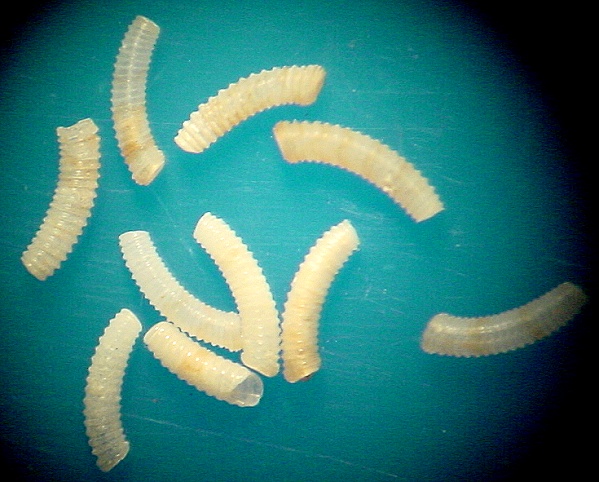The late
Joanne Lightfoot [Lightfoot, J., 1992. Hawaiian Caecidae. Hawaiian
Shell News 40(7): 1,4-5. July] clearly demonstrated "Caecum
arcuatum de Folin, 1867" was an early stage of "C. septimentum
Folin, 1867." The specimen Kay illustrated was a partially-developed
third stage with an adherent second stage - making it a sort of
"hybrid" - and unusually long. The excellent photo of
your shells clearly indicates this species (all are third stages).
So which of the two names the de Folin coined is the proper one
to use?
Well, I went
to my dog-eared photocopy of the works of the Marquis de Folin,
most of which is a series of publications entitled Fonds de la mer.
This work was issued in irregular installments between 1867 and
1887. To say the bibliography is arcane and confusing is a gross
understatement.
The original
description of Caecum sepimentum [note spelling; the species epithet
is a noun meaning "fence" and has nothing to do with "seven"
as Joanne's mis-spelling suggests] was probably in 1867 and is on
page 84 of the "Tome premier." The Marquis considered
it unusual that the mucro, the pointed feature on the posterior
aspect (septum) was lacking on his shells. The illustration is well-drawn,
as de Folin was inclined to do - about four inches in length (vs.
the 2 mm. shell). It is clearly conspecific with your shells. The
type specimen came from Mauritius.
I cannot
find any mention of "Caecum arcuatum" in the Fonds until
the fourth (final) "Tome." I have dated this work as "1881-1887"
On page 24 Caecum sepimentum, var. arcuata [sic] appears; it was
collected off Tahiti. It was not illustrated, but the text indicates
it was "plus courte et plus courbée" - the condition
of an early shell stage. In a passage just before that the author
mentioned receiving C. sepimentum from Honolulu.
I think the
name Caecum sepimentum de Folin, 1867 clearly has chronologic priority
over the synonymous C. arcuatum de Folin sometime between 1881 and
1887. I believe both Kay and Lightfoot had the date of publication
for C. arcuatum incorrect.
Thus the
proper name for your shell is Caecum
sepimentum de Folin, 1867.
Harry L.
